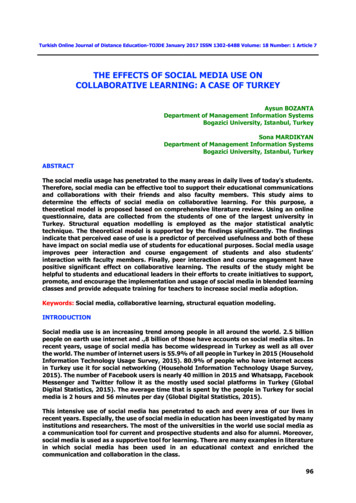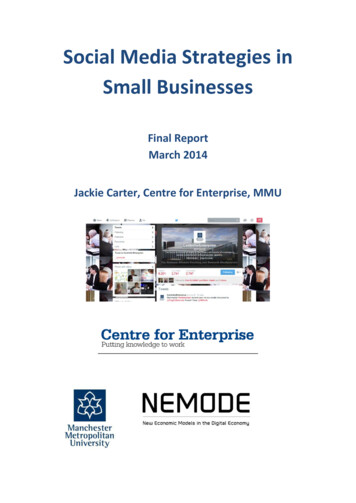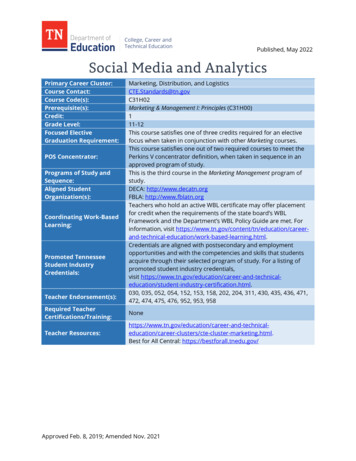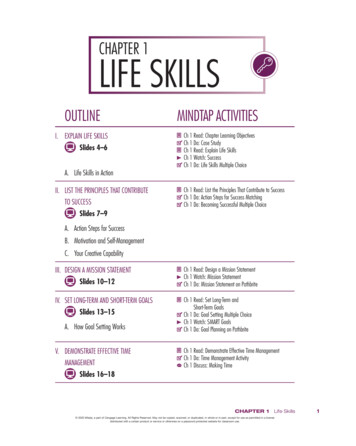
Transcription
Turkish Online Journal of Distance Education-TOJDE January 2017 ISSN 1302-6488 Volume: 18 Number: 1 Article 7THE EFFECTS OF SOCIAL MEDIA USE ONCOLLABORATIVE LEARNING: A CASE OF TURKEYAysun BOZANTADepartment of Management Information SystemsBogazici University, Istanbul, TurkeySona MARDIKYANDepartment of Management Information SystemsBogazici University, Istanbul, TurkeyABSTRACTThe social media usage has penetrated to the many areas in daily lives of today's students.Therefore, social media can be effective tool to support their educational communicationsand collaborations with their friends and also faculty members. This study aims todetermine the effects of social media on collaborative learning. For this purpose, atheoretical model is proposed based on comprehensive literature review. Using an onlinequestionnaire, data are collected from the students of one of the largest university inTurkey. Structural equation modelling is employed as the major statistical analytictechnique. The theoretical model is supported by the findings significantly. The findingsindicate that perceived ease of use is a predictor of perceived usefulness and both of thesehave impact on social media use of students for educational purposes. Social media usageimproves peer interaction and course engagement of students and also students’interaction with faculty members. Finally, peer interaction and course engagement havepositive significant effect on collaborative learning. The results of the study might behelpful to students and educational leaders in their efforts to create initiatives to support,promote, and encourage the implementation and usage of social media in blended learningclasses and provide adequate training for teachers to increase social media adoption.Keywords: Social media, collaborative learning, structural equation modeling.INTRODUCTIONSocial media use is an increasing trend among people in all around the world. 2.5 billionpeople on earth use internet and .,8 billion of those have accounts on social media sites. Inrecent years, usage of social media has become widespread in Turkey as well as all overthe world. The number of internet users is 55.9% of all people in Turkey in 2015 (HouseholdInformation Technology Usage Survey, 2015). 80.9% of people who have internet accessin Turkey use it for social networking (Household Information Technology Usage Survey,2015). The number of Facebook users is nearly 40 million in 2015 and Whatsapp, FacebookMessenger and Twitter follow it as the mostly used social platforms in Turkey (GlobalDigital Statistics, 2015). The average time that is spent by the people in Turkey for socialmedia is 2 hours and 56 minutes per day (Global Digital Statistics, 2015).This intensive use of social media has penetrated to each and every area of our lives inrecent years. Especially, the use of social media in education has been investigated by manyinstitutions and researchers. The most of the universities in the world use social media asa communication tool for current and prospective students and also for alumni. Moreover,social media is used as a supportive tool for learning. There are many examples in literaturein which social media has been used in an educational context and enriched thecommunication and collaboration in the class.96
This study aims to investigate the effects of social media on collaborative learning.Literature is reviewed comprehensively and findings are explained in part two. Theoreticalmodel and hypotheses are explained in part three. The questionnaire, sample, andstatistical method are explained in part four. Data are analyzed and results are discussedin part five. Finally, the study is discussed and its limitations are written in part six.LITERATURE REVIEWSocial media is defined as “. web‐based services that allow individuals to construct a publicor a semi‐public profile within a bounded system, articulate a list of other users with whomthey share a connection and view and traverse their list of connections and those made byothers within the system” (Boyd & Ellison, 2008). In addition, it is defined as internet-basedapplications and tools that provide the creation and exchange of user-generated contentincluding videos, pictures, and written information (Kaplan & Haenlein, 2010; Li & Bernoff,2008). Social media provides active participation, connectivity, collaboration, and sharingof knowledge and ideas among users (McLoughlin & Lee, 2007). These benefits providedby social media are very relevant and necessary for educational context. For this reason,the research of social media use in education is an increasing topic among researchers.There are both qualitative and quantitative studies in the literature which investigate therelationship of social media and education.Different social media platforms were used to examine the effects of social media sites oneducation and collaborative work. Bongdanovs et al. (2012) created their social platformin order to measure the effects of self-created social media platforms for collaborativework. They observed that it is much more effective than typical social networks because itis created for a special purpose. Some of the studies handle social media sites separatelyand investigates the effects of specific one or specific kind of them in educational context.For instance in the study of Quincey and his colleagues (2012), the effects of socialbookmarking sites were examined and it was found that they are very useful for storing,sharing and discovering resources. They are also helpful for creating learning communities(Quincey et al., 2012). Microblogs are another type that was investigated in the study ofEbner and his colleagues (2010) in which it was found that they are new type ofcommunication that can help informal learning at outside of the classrooms. Moreover, theuse of social media for educational purposes was analyzed also qualitatively byinterviewing with university students and results showed that they use social mediaintensively for educational purposes such as exchanging practical and academicinformation, experiences, social support and also connecting with peers and sharingdocuments (Hrastinski and Aghaee, 2012).It is stated that there is a positive significant relationship between academic uses ofinformation technology and the occurrences of collaborative learning, and also academicuses of technology increases the interaction between students and also student and facultymembers (Laird & Kuh, 2005; Junco et al., 2013). Grosseck and Holotescu (2010) alsohighlighted that microblogging is an effective tool for collaboration in educational context.Moreover, it was indicated that there is a correlation between the social media usage ofstudents and the relationship between them (Rutherford, 2010; Rodriguez, 2011; Junco etal., 2013). It is appeared in the study of Hung and Yuen (2010) that students felt socialconnectedness more when social networking sites are used as supplementary tool forteaching.On the other hand, the study of Wiid and his colleagues (2013) indicated that the mostimportant factors according to the students’ perceptions that affect the use of social mediaas an effective lecturing tool are ‘Ease of use’ and ‘Accessibility’. Al-Rahmi and hiscolleagues (2014) also use two variables of technology acceptance model which are“perceived ease of use” and “perceived usefulness” and with these variables they also use“engagement”, “peer interaction” and “faculty interaction” as the predictors ofcollaborative learning. In addition to this, they also investigates the effect of collaborative97
learning and student satisfaction. Finally they examined the effects of collaborativelearning and student satisfaction on student’s academic performance. All relations werefound as significantly effective on indicated variables.In summary, there are researches exploring the effects of social media on collaboratinglearning. However in this study, main dimensions of technology acceptance model (TAM);perceived ease of use and perceived usefulness were used as the predictors of social mediausage of students. It was claimed that social media usage of students is the indicator ofinteraction among students, also interaction among students and faculty members andcourse engagement. In addition, the effects of these three variables (student interaction,interaction between students and faculty members and course engagement) oncollaborative learning were highlighted. All of these relationships are investigated in asingle model which has not been proposed before in the literature.THEORETICAL MODEL AND HYPOTHESESPerceived Ease of UseFirst of all, variables which affect the social media use are taken from basic TechnologyAcceptance Model (TAM) as “perceived usefulness” and “perceived ease of use” (Davis,1989). Perceived ease of use has positive effect on perceived usefulness and also socialmedia use and intention to use social media (Lim et al., 2013; Rauniar, 2013). Moreover,previous study from the literature revealed that perceived ease of use of social media haspositive impact on social media use in educational concept (Wiid et al., 2013).Perceived UsefulnessPerceived usefulness is defined as ‘‘the degree that an individual thinks that utilizing aparticular system would enhance his/her performance’’ (Davis, 1989). Recent studies inthe literature show that perceived usefulness has a positive significant impact on socialmedia use and intention to use social media (Lim et al., 2013; Rauniar, 2013). Moreover,previous study from the literature revealed that perceived usefulness of social media foreducation has positive impact on social media use for education (Wiid et al., 2013).H1: Perceived ease of use of social media has positive significant impact on perceivedusefulness of social mediaSocial Media UsageSocial media usage variable measures students’ actual usage of social media foreducational purposes. Thus the discussion above leads to following hypotheses:H2: Perceived usefulness of social media has positive significant impact on actual useof social media.H3: Perceived ease of use of social media has positive significant impact on actual useof social media.Student InteractionStudent interaction is created to measure the communication and information sharingbetween students among each other. In previous studies, it was stated that social mediausage may have increasing effect on interaction between students (McLoughlin & Lee,2007; Laird & Kuh, 2005; Junco et al., 2013). In this study, it is claimed that social mediausage increases student interaction:H4: Actual use of social media has positive significant impact on student interaction.Interaction between Students and Faculty MembersInteraction between students and faculty members is created to measure thecommunication and information sharing between students and faculty members especiallywith instructors. In the literature, it was mentioned that the social media usage of studentsmay have increasing effect on the interaction between students and faculty members (Laird& Kuh, 2005; Junco et al., 2013; Al-Rahmi, 2014). Based on the previous literature,following hypothesis was constructed:98
H5: Actual use of social media has positive significant impact on interaction ofstudents with faculty members.Course EngagementEngagement means “the intensity and emotional quality of children’s involvement ininitiating and carrying out learning activities” (Connell & Welborn, 1991; Skinner, 1991cited by Skinner & Belmond, 1993). In many studies in the literature, it was found thatthere is a correlation between use of social networking sites and students’ engagement(Heiberger &Harper, 2008; Rutherford, 2010; Rodriguez, 2011; Junco et al., 2012, 2013).Therefore, the arguments above leads to the following hypothesis:H6: Actual use of social media has positive significant impact on students’engagement.Collaborative LearningCollaborative learning is defined as following “it is a situation in which two or more peoplelearn or attempt to learn something together” (Dillenbourg, 1999). In the study of Al-Rahmi(2014), it is found that perceived ease of use and perceived usefulness of social mediastudent engagement, Student Interaction and interaction between students and facultymembers are the predictors of collaborative learning. Grosseck and Holotescu (2010) alsohighlighted that social media is an effective tool for collaboration with students. Thus theargument above leads the following hypotheses:H7: Student interaction has positive significant impact on collaborative learning.H8: Interaction of students with faculty members has positive significant impact oncollaborative learning.H9: Students’ engagement has positive significant impact on collaborative learning.In order to measure the effects of social media on collaborative learning, the theoreticalmodel (Figure 1) was proposed by depending on the literature review. As a result ofliterature review, there is no such a complete theoretical model investigating the effects ofsocial media usage of students on collaborative learning. Although, relationships betweenconstructs in the model are investigated partially in different studies, this model is novelfrom various perspectives. For instance, the model is not only includes all related variablesin a complete theoretical model, but also indirect and direct effects of independentvariables were also measured in this model.Figure 1. Theoretical Model99
METHODDataIn line with the research objectives of this study, an online survey was developed and appliedto a convenience sample of students of one of the largest university in Turkey. To be able toreach students from different levels (undergrad and grad) and departments, the survey was emailed to the students registered in that specific semester by institutional communicationoffice. Out of 231 respondents, 166 complete surveys were used in structural equation modeling(SEM) by handling missing values with the complete case analysis. Hair et al. (2010) indicatethat it requires minimum 150 sample size with a research model including seven or lessconstructs, modest communalities, and no unidentified constructs for SEM.MeasuresThe questions from previous studies were adopted or directly retrieved from the existing scalesfor this study. The survey consists of 8 sections.The first section of the survey includes 3 demographic questions which ask for gender, age andeducational level of the respondents. 7-point Likert scale questions were used in the remainingparts of the survey. Perceived ease of use and perceived usefulness which are the basic variablesof TAM were asked in second and third parts of the survey respectively. The fourth part of thesurvey which has a question with 3 items is about actual use of social media. This scale wasadopted from the study of McGowan and his colleagues (2012). The fifth, sixth and seventhsections of the survey includes questions about student interaction, faculty member interactionof students and course engagement level of students, having 4, 4 and 3 items respectively.Question about collaborative learning was asked as the eighth part of the survey having 4 items.The scales except from fourth one were adopted from the study of Al-Rahmi (2014) (AppendixA).Although all questions were adopted or directly retrieved from the existing scales, validity andreliability analyses were applied in the confirmatory factor analysis part.FINDINGSDescriptive StatisticsThe demographic profile of the respondents is presented in Table 1. 65% of the respondentswere female and 35% were male. The age range varies from 18 to 45, mean value of age is23.14 and the standard deviation is 3.54. 72% of the respondents are at the bachelor's level,19% of the respondents are at the master level and 9% of the respondents at the PhD level.Table 1. Demographic Profile of RespondentsAgeGenderEducationMinMaxMeanStandard r's Level MasterPhD11972%159%3219%Structural Equation ModelingStructural equation modeling (SEM) which examines a set of relationships between one ormore observed independent variables, either continuous or discrete, and one or moredependent variables, either continuous or discrete; both of which can either be factors ormeasured variables (Ullman, 2000) by combining factor analysis and path analysis (Kaplan,2000), was applied in this study. Analysis of Moment Structure (AMOS version 22) softwarewas benefitted in the analyzing the data that was gathered from the students of one of thelargest university in Turkey.100
Confirmatory factor analysisThe skewness and kurtosis values of each indicator and also standardized residual covariancematrix were examined for multivariate normality. For each variable, skewness and kurtosisvalues were in the range between -2 and 2. In addition, the standardized residual covariancematrix and largest standardized residuals were analyzed for evidence of normality. With the useof covariance matrices, small residual values ( 0.05) are indications of normality (Bentler,1995). Large values of covariance residuals tend to be influential in lack of model fit and areanother measure of normality when using covariance matrices (Bentler, 1995). A review of thelargest standardized residuals revealed no large values. All absolute values were less than 2 forall indicators. Therefore, it can be stated that each variable satisfies the normality requirement.Thus, maximum likelihood model was chosen as estimation technique.Confirmatory factor analysis that is the first step of SEM was applied and factor loadings, factorloading squared, measurement errors and p-values were calculated (Table 2). Measurementmodel and its standardized regression weights can be examined in Appendix B.Latent VariableTable 2. Confirmatory factor analysis resultsIndicatorFactorFactor Loading p- ValueLoadingSquaredPerceived 0.81-*0.0010.0010.001Perceived Ease of cial Media Actual UsageSM1SM20.850.760.720.58-*0.001Student .810.760.0010.0010.001Interaction between Students FI1and Faculty 0.770.79-*0.0010.001Collaborative 50.640.300.0010.001*not estimated when loading set to fixed value of 1.0101
According to Hair (2009) factor loadings should be at least 0.50 and ideally 0.70 or greater.Furthermore, squared of factor loadings should explain half of the variable even if at least0.50 factor loadings are significant. Indicators PE1 and CL4 have both 0.55 factor loadingswhich is not ideal but more than acceptable level. They do not violate the constructintegrity. Moreover, all values are significant with p value 0.001.Table 3 shows the goodness of fit indices for the measurement model and acceptable fitintervals. Chi-square and the root mean square error of approximation were chosen asabsolute fit indices and normed fit index (NFI) and comparative fit index (CFI) weredetermined as incremental fit indices, and parsimonious comparative fit index (PCFI) weredetermined as parsimony fit indices for this study. Chi-square value of measurement modelis 427.892 and degree of freedom is 231. The ratio of chi-square over degrees of freedomis 1.85, ( 3.00). RMSEA was found as 0.072 which satisfies the acceptable fit value ( 0.08). Moreover, NFI and CFI were found as 0.90 and 0.95 respectively. These twoincremental indices also satisfied the acceptable fit values ( 0.90). All values of goodnessof fit indices and their acceptable values can be seen in Table 4 under the model fit section.Overall, it can be said that the measurement model provided a good fit to the data.Table 3. Goodness of fit indices for the measurement modelGoodness of Fit IndicesValuesAcceptable FitsChi-Square427.892Degrees of Freedom231Absolute Fit MeasuresRMSEA0.072.05 RMSEA .08Normed Chi-Square1.85X2/df 3NFI0.90.90 NFI .95CFI0.95.90 CFI .95Incremental Fit IndicesParsimony Fit IndicesPCFI0.80.80 PCFI .90Construct validity consists of convergent validity, discriminant validity and face validity. Inorder to ensure convergent validity of the constructs, factor loadings, average varianceextracted and reliability of the constructs were calculated. It is observable at the standardloading column and their p-values that all indicators ensure adequate standard loadingvalue ( 0.5) at the alpha level 0.1% (Table 2). Table 4 shows reliability values (Cronbach’sAlpha values), average variance extracted and composite reliabilty values. For each latentvariable Cronbach’s Alpha values are greater than 0.70 that supports instrument’sreliability. Moreover, each AVE met the recommended minimum threshold of 0.50. Allcomposite reliability values exceeded the recommended level of .70. Convergent validitywas assessed using factor loading, construct reliability, and average variance extracted(Hair, Black, Babin, Anderson, & Tatham, 2006). Therefore, all factors in the measurementmodel had adequate convergent validity.102
Table 4. Convergent Validity ValuesLatent VariablePerceived UsefulnessPerceived Ease of UseSocial Media ActualUsageStudent InteractionFaculty InteractionEngagementCollaborative LearningReliability (Cronbach’sAlpha)Average 40.650.950.990.910.83Then discriminant validity of the model was examined. Each correlation between constructsand their AVE values can be seen in Table 5. Most of the AVE values of constructs are greaterthan the square of correlation between constructs except perceived usefulness andcollaborative learning pair. However, these two constructs are totally different constructsand there isn’t any similarity between their indicators so it can be said that nearly allconstructs satisfy discriminant validity requirement.Table 5. Discriminant ValidityConstruct 1Construct 2CorrelationSquare ofCorrelationAVE ofConst 1AVE ofConst 2PerceivedUsefulness - ess - SocialMediaUse0,650,420,780,65PerceivedUsefulness - ess - ulness - ess - Engagement0,770,590,780,74SocialMediaUse - on - on - OfUse - on - Engagement0,630,400,800,74PerceivedEaseOfUse - SocialMediaUse0,660,430,570,65SocialMediaUse - FacultyInteraction0,460,210,650,89SocialMediaUse - e - Engagement0,660,430,650,74PerceivedEaseOfUse - on - CollaborativeLearning0,550,300,890,64Engagement - vedEaseOfUsePerceivedEaseOfUse - - - “The term 'face validity' implies that a test which is to be used in a practical situationshould, in addition to having pragmatic or statistical validity, appear practical, pertinentand related to the purpose of the test” (Nevo, 1985). In order to express each constructcorrectly, it is important to understand its meaning and content. Therefore, at the verybeginning of the study, each construct should be investigated from the literaturecomprehensively. In addition, their relationship should be constructed correctly based on103
a literature. In this study, all constructs were taken from the literature directly or adoptedfrom the literature.Structural model validityThe structural model was tested for structural model validity which includes hypothesestesting and model fit. Chi-square was found as 545, 211 and degrees of freedom is 244which implies that Chi-square in the acceptable range since it should be less than 3 degreesof freedom ( 3d.f.).Chi-square over degrees of freedom was chosen as absolute fit index and comparative fitindex was determined as incremental fit index for structural model. It can be observed inTable 6 that, both indices are in the acceptable range. Therefore, it can be said thatstructural model also satisfies model fit requirements.Table 6. Goodness of fit indices for the structural modelGoodness of Fit IndicesValuesChi-Square545.211Degrees of Freedom244Acceptable FitsAbsolute Fit MeasuresNormed Chi-Square2.23X2/df 30.92.90 CFI .95Incremental Fit IndicesCFIAfterwards, regression weights and their p-values that can be seen in Table 7 werecalculated. It can be seen that, all regression weights are significant at the alpha level 0,05except the hypothesis 8 which shows the effect of interaction between students and facultymembers on collaborative learning. Therefore, this relation was deleted from the model.The structural model’s regression weights were calculated again for the updated version ofthe model and the regression weights were found as same with the previous model. Theupdated version of structural model and its standardized regression weights can beexamined in Appendix C.Table 7. Regression WeightsRelationships of Constructsp-valueH1: Perceived Usefulness -- Perceived Ease Of UseRegressionWeight0.807H2: Social Media Use -- Perceived Usefulness0.639.000H3: Social Media Use -- Perceived Ease Of Use0.319.004H4: Student Interaction -- Social Media Use0.82.000H5: Interaction between students and faculty members -Social Media UseH6: Course Engagement -- Social Media Use0.599.0000.88.000H7: Collaborative Learning -- Student Interaction0.22.006H8: Collaborative Learning -- Interaction between students andfaculty membersH9: Collaborative Learning -- Course Engagement-0.001.9920.73.000.000104
Modification indices were examined to determine whether there is a relationship that wasunnoticed and can improve structural model. It is recommended that “Modification indicesof approximately 4.0 or greater suggest that the fit could be improved significantly byfreeing the corresponding path to be estimated” (Hair et al., 2009). However, anymodification index that causes a change in our model haven’t been appeared in theanalysis.DISCUSSIONS and CONCLUSIONThis study proposes a model that investigates the effects of social media usage of studentsfor educational purposes on collaborative learning. This model was constructed bydepending on the findings of previous literature and tested by structural equationmodeling. The basic technology acceptance model was applied on social media usage ofstudents for educational purposes. Then, the effects of social media usage of students foreducational purposes on student interaction, faculty member interaction with students andcourse engagement of students were examined. Finally, the overall effects of studentinteraction, faculty member interaction with students and course engagement of studentson collaborative learning were determined.The main research results are summarized as follows. Perceived ease of use has positivesignificant effect on perceived usefulness; they both affect social media usage of studentsfor educational purposes positively. Social media usage of students improves studentinteraction and course engagement of students and also interaction between students andfaculty members. Student interaction and course engagement have positive significantimpact on collaborative learning. However, interaction of students with faculty membersdoesn’t have significant effect on collaborative learning.Results of this study are consistent but not limited to results in previous studies. Both directand indirect effects of perceived ease of use on actual usage of social media are measuredin this study. As it was indicated in the literature, active technology use for educationalpurposes increases the interaction between students and also students and facultymembers (Laird & Kuh, 2005; Junco et al., 2013). Moreover, it was also supported that theuse of social media has significant impact on student engagement (Rutherford, 2010;Rodriguez, 2011; Junco et al., 2013). In the study of Al-Rahmi (2014), it was found thatperceived ease of use and perceived usefulness, engagement, student interaction andinteraction between students and faculty members as the predictors of collaborativelearning. However, in this study, the effects of perceived ease of use and perceivedusefulness on social media usage. The effects of social media usage on student interaction,interaction between students and faculty members and course engagement were measuredand positive significant impact was determined. Student interaction and engagement havedirect impacts on collaborative learning. In addition, social media usage, perceivedusefulness and perceived ease of use have indirect effects on collaborative learning. Allthese relationships were analyzed in a single model.Some limitations should be noted in this study, and the following suggestions for furtherresearch will be worth future efforts in this field. First, the sample of this study is limitedto students of a large university in Turkey. Therefore, this study can be applied to otheruniversity students in the same country and also in other countries for generalizability.105
BIODATA and CONTACT ADDRESSES of AUTHORSAysun BOZANTA is a PhD candidate and Research Assistant in theDepartment of Management Information Systems at BogaziciUniversity, Turkey. She earned M.A. degree from Bogazici UniversityDepartment of Management Information Systems and B.Sc. doublemajor degree in Management Information Systems and MathematicalEngineering Departments. Her primary research interests includedata analy
Therefore, the arguments above leads to the following hypothesis: H6: Actual use of social media has positive significant impact on students' engagement. Collaborative Learning Collaborative learning is defined as following "it is a situation in which two or more people learn or attempt to learn something together" (Dillenbourg, 1999).











